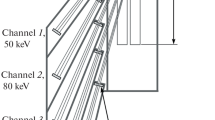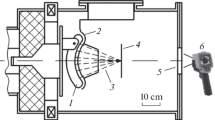Abstract
An ablation of a thin layer of surface contamination of the target that self-recovers after each pulse of a powerful ion beam has been used to control ion fluences. Using a time-of-flight optical spectrometer, the average speeds of the lightest components of the ablative plasma, which are hydrogen and carbon, have been measured. and the ion fluence has been determined by their difference.
Similar content being viewed by others
Avoid common mistakes on your manuscript.
It was shown in [1] that, after being cleaned by a powerful pulsed ion beam, the surface contamination layer of a solid target is partially restored within a few seconds. The ion-activated surface adsorbs hydrogen, carbon, and oxygen from water vapor and oils in the residual atmosphere of the accelerator vacuum chamber. It was shown using time-of-flight mass spectrometry in [2] that the main contribution to the composition of the residual gas in the cyclotron chamber is made by the molecules of the vacuum oil used (up to 82 vol %) and water molecules (up to 15–17 vol % ) and to that in the ion conductor—by water molecules (up to 63 vol %). The Langmuir probe method was used in [3] to study the time-of-flight characteristics of an ablative plume that occurred at a short-pulse (15 ns) laser radiation energy with a wavelength of 532 nm input in a two-component MnSi target in a vacuum and in an argon atmosphere, by which distribution function of the concentration of charged particles over the expansion speed for various values of the buffer gas pressure in the vacuum chamber were obtained. The time-resolved emission spectra of light emitted by a propagating ablative plasma plume generated by a powerful ion beam of the TEMP-2 process accelerator in a polyethylene target were measured in [4]and it was shown that the main products of the expanding plume are represented by the matrix elements: H, C, C2, and CH.
Hydrocarbon contamination of the surface is sublimated when the specific energy is input at the level of 0.2–0.3 J/mg, which is achievable for 300- to 400-keV protons at their fluences already at the level of 1013 protons/cm2 per pulse. In this case, the sublimated products of surface contaminants (H, C, N, and O) can be atomized and ionized so as to form the plume of a rarefied ablative plasma, which propagates mainly along the normal from the target surface because of the geometry. The lightest plasma components (hydrogen and carbon), as well as oxygen, should propagate at the front of the plume, which allows for time-of-flight spectrometry of these fastest gas components and calculation of the energy Q input in the target unit area by their relative speeds.
Without taking into account the gas dynamic acceleration of the plasma boundary layer and energy losses during energy input by ions, the average speed \({{{v}}_{i}}\) of components of ablative plasma (H, C, O, etc.) can be roughly determined from their masses Mi and temperature T immediately after the pulse:
where k ≈ 1.38 × 10–23 J/K is the Boltzmann constant.
The temperature can be expressed in terms of energy Q input or fluence of ions Φ as
where Sav is the average braking energy losses of ions in the layer (J/(mg cm2)) and Cp is the specific heat capacity of contamination hydrocarbons at constant pressure.
Since an accurate determination of the specific heat capacity of the contamination layer is impossible, the best method is relative calculation of the input energy or ion fluence by the difference in the time-of-flight of the fastest plasma components, hydrogen (τH) and carbon (τC), along the baseline with length L when proportionality coefficient K is found by calibration for each series of experiments of the same type:
Because the surface contamination layer is restored within a few seconds, it becomes possible to determine input energy Q or fluence of ions Φ immediately after each pulse of the powerful ion beam by measuring the relative speeds of H- and C- (and/or O-) components. The extremely small layer thickness (≪100 nm) does not affect the speed of the hydrogen and carbon components or, as a result, the determination of the ion fluence and the input energy. The composition of the contamination layer is almost independent of the type of material being processed, and so any material that is convenient for subsequent calibration can be used during the time-of-flight spectrometry.
The aim of this work is to test the possibility of diagnostics of high-power pulsed ion beams by the time-of-flight of the hydrogen and carbon components of the ablative plasma generated in the layer of surface contaminants. The measurement the propagation speeds of hydrogen and carbon of the ablative plasma was performed using optical time-of-flight spectrometry of the propagation of the luminous front of the ablative plume. A diagram of an optical time-of-flight spectrometer used for diagnostics of the beam of the TEMP-1 technological accelerator (Tomsk Polytechnic University) is presented in Fig. 1. A narrow layer of the plume front of the rarefied ablative plasma formed by a layer of surface contamination on the titanium foil was examined by a PMT110 photoelectronic multiplier coupled with a Tektronix TDS224 digital oscilloscope through a slit diaphragm (1–2 mm) and light filters after each pulse of a TEMP-1 accelerator. The slit diaphragm selects photons emitted by ablative plasma components at distances of 1–3 cm from the target. Since hydrogen and carbon are the fastest components of the ablative plasma under consideration, gray filters were chosen to provide the widest possible range of light transmission and reduce the load of the PMT for the very first pulses of the series when the signal amplitude is assumed to be several times greater than for the rest of the pulses on average. When necessary, selective filters can achieve additional separation of analytical signals by selective absorption of photons of the interfering ablative plasma components.
Figure 2 shows the time-of-flight spectra of the first, second, fifth, and sixth pulses of the same series, and Table 1 presents the total results for these pulses. It can be seen that the signals from the hydrogen and carbon components are separated quite simply and when the ion fluence on the target (the input energy) increases, the time interval between the signal peaks from the C- and H-components ΔτH–C decreases, which for a given time resolution of the spectrometer (primarily PMT) imposes a constraint on the upper limit of the recorded ion fluences. The lower limit is mainly set by the condition of inputting ion energies sufficient for ablation of the surface contamination layer in this layer, for example, not less than 1013 cm–2 per pulse for 300- to 400-keV protons, as indicated above.
The very first pulse of the series generates the highest amplitude light signal and ion fluence at the maximum energy input in the titanium foil measured using calorimetry (Q = 85 cal). Since the surface contamination, including that of the diode electrodes, is maximum before the very first pulse of any series, this result suggests a high contribution of surface contamination to the emission of ions by the accelerator electrode system. The second pulse of the series confirmed this conclusion since it was produced 2–3 s after the first one, while the pause between pulses was reduced by half compared to the usual 4–5 s. This was done in order to estimate the typical time needed to restore the surface contamination layer. In the second pulse, not only the amplitude of the light signal decreased (by ten times), but the difference in time-of-flights between the peaks of the hydrogen and carbon components of the ablative plasma increased as well, which indicates a decrease in its temperature and, as a consequence, a sharp drop in the energy input by ions because of their decreased fluence. The return to the normal pulse repetition rate of 4–5 s, which was found empirically for the TEMP-1 accelerator [1], allowed reaching the level of thermal energy input in titanium foil within 50–65 cal, which is on average about 1.4 times lower than in the most powerful (first) pulse, but 1.7 times higher than in the artificially “suppressed” second one.
The column of values Q* gives an idea of the input energies if they are calculated from the difference in the time-of -light of carbon and hydrogen ions along the baseline length L = 2 cm ΔτH–C, calibrating the subsequent values of the pulse series by calorimetric data on the very first pulse, i.e., assuming \(Q_{1}^{*}\) = 80 cal. The difference from the data in the Q column expressed as a percentage in the column δ = 100%(Q–Q∗)/Q gives an idea of the error of such definition of the energy input or of the proton fluences, on average, overestimating the values in the subsequent pulses (regarding the first one) by approximately +6.2% (with an RMS deviation of ±5.9%), which is probably due to the marked specificity of the very first impulse of any series as the most powerful one and likely including a maximum admixture of heavy ions (mainly carbon). Selecting Q** = 65 cal as the calibration value for the fifth (“normal”) pulse of the series reveals a decrease in the error of determining the energy input (and proton fluence), on average, to –2% (with the same standard deviation of ±5.9%).
The relative position of all the picks also agrees well with the hypothesis of their occurrence as ablated components of surface contamination—mainly H, C, and O, as well as partially the surface of the titanium matrix itself. According to the initial assumptions with rough simplifications, the ratio of the time-of-flight of individual components should be as follows:
τH/τC = \(\sqrt {12{\text{/}}1} \) = 3.463, which corresponds to the detected average for four pulses of the series (3.37 ± 0.07);
τH/τO = \(\sqrt {16{\text{/}}1} \) = 4, which corresponds to the detected average (3.96 ± 0.5);
and τH/τTi = \(\sqrt {47.9{\text{/}}1} \) = 6.92, which corresponds to the detected average (6.78 ± 0.4).
While the calorimetry data are in agreement with the time-of-flight data, the results of electric current measurements differ from both the time-of-flight and calorimetry data, which indicates their unreliability. In general, optical time-of-flight spectrometry coupled with calorimetric measurement of the thermal energy input shows good reproducibility of results at the level of at least ±6%. Detected differences in data on the thermal energy input (proton fluences) for the first and second (artificially suppressed) pulses, as well as for the subsequent two pulses of the series, indicate that surface contamination can be the dominant source of ions for the electrodes operating on the principle of explosive emission, which opens up additional possibilities including for collective acceleration of ions.
REFERENCES
G. E. Remnev, I. F. Isakov, M. S. Opekunov, V. M. Matvienko, V. A. Ryzhkov, V. K. Struts, I. I. Grushin, A. N. Zakoutayev, A. V. Potyomkin, V. A. Tarbokov, A. N. Pushkaryov, V. L. Kutuzov, and M. Yu. Ovsyannikov, Surf. Coat. Technol. 114, 206 (1999).
N. N. Aruev, M. A. Kozlovskii, M. F. Kudoyarov, M. Ya. Patrova, P. A. Romanov, R. V. Tyukal’tsev, I. L. Fedichkin, and S. V. Filippov, Tech. Phys. Lett. 45, 827 (2019).
O. A. Novodvorskii, V. A. Mikhalevskii, D. S. Gusev, A. A. Lotin, L. S. Parshina, O. D. Khramova, and E. A. Cherebylo, Tech. Phys. Lett. 44, 271 (2018).
J. Zhang, C. Tan, W. Wang, Y. Wang, and T. Ma, J. Korean Phys. Soc. 42, 885 (2003).
Funding
This work was supported by the Russian Science Foundation, project no. 17-19-01442.
Author information
Authors and Affiliations
Corresponding author
Ethics declarations
The authors declare that they have no conflict of interest.
Additional information
Translated by N. Petrov
Rights and permissions
About this article
Cite this article
Ryzhkov, V.A., Nechaev, B.A. & Padalko, V.N. Time-of-Flight Optical Diagnostics of High-Power Pulsed Ion Beams. Tech. Phys. Lett. 46, 354–356 (2020). https://doi.org/10.1134/S1063785020040136
Received:
Revised:
Accepted:
Published:
Issue Date:
DOI: https://doi.org/10.1134/S1063785020040136






